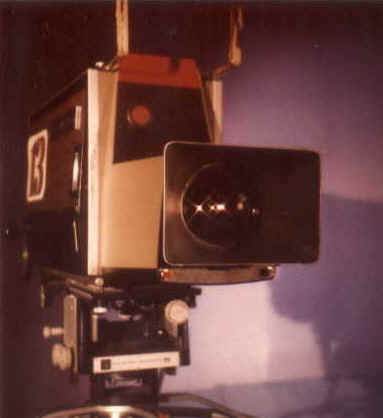
The General Electric P.E. 400 served WTVT
for most of the 1970s.
MOVING ON

The General Electric P.E. 400 served WTVT
for most of the 1970s.
As the 60's ended and WTVT
entered the "Me" decade of the 70's, it was the end of the road for
the TK-42s. "We were extremely
pleased to get rid of the TK-42s," admits Adrian, "and the station
donated them to the local PBS affiliate, WEDU.
Because we had a track record with the G.E.s, we bought four new P.E.
400's for the studio around late 1970. We thought we'd died and gone to
heaven."
The engineering department
saw the departure of Lawton Melcalfe and Jack King, who both went to work for
the University of South Florida. "Jack's
true love was weather, and he went to work at USF with a department that built
special weather projects, recalls Adrian.
"Lawton died in the early 70's.
At the time we hired Frank Rankel, a former WEDU engineer who was working
at Florida Atlantic College on the east coast.
Frank became a WTVT engineer, then a remote supervisor, and later Chief
Engineer, and later a salesman for Sony."
Adrian left WTVT for Lykes
Electronics, where he installed closed-circuit cameras in race tracks and Hi
Alai frontons. He then worked for a
company that televised horse racing. The
chief engineer of WFLA called Adrian back to work in the mid-70s.
After automating the Channel 8 transmitter, former WTVT chief
photographer Billy Bowles offered him a position with GTE's downtown Tampa
production studio, which meant regular hours and weekends off.
Adrian was engineer for the studio and worked with former WTVT employees
Paul Koenig and Dave Rosenblatt . Adrian
was with the GTE TV studio until deregulation took away the engineering budget
and he opted to move to the fiber optic transmission area, where he retired in
1993. These days Adrian enjoys
keeping up with technology through trade journals.
His hobby is flying R.C. aircraft, and spending time with his teenage
son.
Looking back, Adrian says
it was a great ride and an interesting time to be in television.
"I was extremely fortunate to have been able to participate in a
technology that was changing so rapidly. In
1958, television was just starting to become a national force.
To have been in television and experience the changes like black and
white to color…from a mechanical, 5 button switcher to the Grass Valley 1600
we had at the phone company. Satellites,
video tape, disc recorders, camcorders etc.
From '58 to '80, to see what happened to the technology was absolutely
amazing. I don't think we'll see
such technology leaps again…going from the dark ages to the high-tech stuff.
I still keep up with the trade journals.
And eventually, I will own a high definition set."
# # # # # #
|
PULSE EXTRA |
TO RETURN TO 'FACILITIES' MENU, CLICK HERE
TO RETURN TO 'MAIN MENU,' CLICK HERE